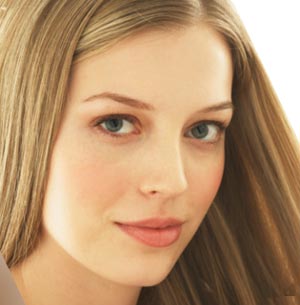For most women, a healthy head of hair is a fleeting pleasure--a not-so-cheap thrill that seems to end the moment we tip our hairdressers. Even if we can prolong our post-salon glow, within a few weeks, it?s inevitably replaced by multiplying mobs of split ends and shower caddies resembling hair rehab clinics.
According to a recent Pantene survey, more than 70 percent of women believe their hair is damaged--a problem their stylists are all too familiar with. ?When hair is shoulder length or longer, it?s usually split or dry,? says Gil Ferrer of the Gil Ferrer Salon in New York City. The good news is, you can get your strands into shape by replacing a few bad habits with Beauty Addict's 12-step healthy routine.
Breaking the Cycle
Ironically, the same tricks and tools we use to improve our hair?s appearance often lead to lasting damage. According to Ferrer, ?color, perms and straighteners are all harmful, especially when they?re combined.? To create the desired effect, these chemicals disrupt the cuticle--the hair?s delicate outer coating. When that layer is permeated or frayed, hair becomes dull, dry and brittle.
Even so, an estimated 60 percent of U.S. women color their hair, and 40 percent of them opt to go blonde. Sadly, ?products that create double-processed, lighter-blonde shades are particularly hazardous,? explains hairstylist Matt Yeandle. If you?re determined to dye, Yeandle suggests sticking with a single-process color and avoiding re-coloring the same strands, which ?can cause serious damage.? In addition, many stylists recommend staying within two shades of the hair?s natural hue or using gentler, semipermanent products.
But the chemically dependent aren?t the only ones at risk; friction and hot tools can be equally unsafe. ?Going to bed with wet hair leaves strands more vulnerable to friction,? says Yeandle. After showering, he recommends lightly squeezing hair with a towel, using a wide-tooth comb to remove tangles and, once it?s dry, brushing gently, rather than vigorously. Alicia Trani, of New York City?s Mudhoney salon, also warns against overwashing, as well as potentially harmful accessories: ?Uncoated rubber bands and tight ponytails worn every day are going to cause damage,? she notes.
The 12 Step Program
As with most things, the road to hair recovery is paved with care, caution and self-control. Follow the experts? advice to get your tresses on the right track.
1. Cut and Run
To prevent split ends, experts stress the importance of trimming your hair every three to four weeks.
2. Beware the Razor
Be mindful of the tools your stylist is using. ?Although razors can create beautiful styles, they can compromise the hair?s cuticle,? says Yeandle.
3. Keep in Condition
According to colorist Erika Szabo, of New York City?s Louis Licari Salon, generous conditioning is crucial to maintaining a healthy mane.
4. Go Deep
Rather than relying solely on standard rinse-outs, Szabo also suggests ?saturating dry hair with conditioner, covering it with a shower cap, and keeping the cap on when showering, to let the steam activate the conditioner.?
5. Make an Investment
Poor-quality accessories can undermine even the best hair-care regimen. For best results, invest in an extra-gentle boar?s-hair brush and fabric-covered elastics, which create stress-free styles.
6. Choose the Right Tools
If you insist on heat-styling, stick with ceramic tools, which ultimately cause less damage than the metal variety.
7. Fight the Elements
Sun, wind, salt water, and chlorine can all damage the hair?s cuticle. Szabo recommends using UV-protective products, which also keep color from fading.
8. Beat the Heat
Blow-dryers, flatirons, and curling irons can all take a heavy toll on hair. If you?re unwilling to forgo the heat, limit yourself to weekly usage.
9. Hold Back
When blow-drying, use a diffuser or nozzle, and always keep the dryer at least six inches from the hair.
10. Keep It Moving
Flatirons should be kept in constant motion to prevent singeing, and curling irons should be carefully timed, following manufacturers? instructions.
11. Get a High-Pro Glow
Nourish your hair at home, but leave heavy-duty chemical processes to the professionals.
12.Shop Around
Remember that perhaps the most important step in preventing damage is choosing the right hairdresser: ?Make sure your stylist is knowledgeable, understands your hair, and won?t use damaging methods,? says Ferrer.
Happy Endings
Drugstores and salons are teeming with products that claim to restore, rejuvenate, and repair. According to Ferrer, ?there?s really no way to reverse damage; the hair has to grow back.? Fortunately, the following products can help improve the look of battered locks and prevent new growth from suffering the same fate.
Mild shampoos such as Bumble and Bumble Gentle, Jean-Marc Maniatis Anti-Frizz, and Garnier Fructis Fortifying are specially formulated to protect and nourish. Daily conditioners like Paul Mitchell Super Charged and June Jacobs Citrus Clarifying leave hair silky and manageable. For weekly hydration, try deep conditioners such as K?rastase Masqueintense or L?Or?al Color Care Dry Defense 3-Minute Treatment. For heat-activated help, V05?s Hot Oil Treatments offer first-class moisture, while Nutriol?s Hair Fitness contains 12 vials of patented strengthening serum. Clinique Quick Detangle gets wet tresses tangle-free; Infusium 28 Heat-Activated Leave-In Treatment fortifies strands while you blow-dry; and Neutrogena Triple Moisture Healing Shine Serum is a premium polisher, improving the appearance of split ends.
Tara Mattarazzo is the editor-in-chief of Beauty Addict Magazine http://beautyaddictmag.com. For more articles on beauty, hair care, skin care, makeup, fashion, shopping, fitness, women's health, and more, visit the Beauty Addict Magazine features page at: http://beautyaddictmag.com/thescoop/features/featureindex.html
